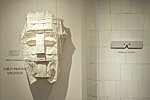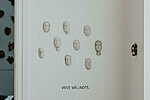5.01. - 12.03.2022
Masks
One day we will wear masks every day – this unusual and incredible prophecy has become threateningly commonplace now. The festiveness or uniqueness of masks seems to have completely disappeared, and there is a vast army of modern unified and standardised masks peering some aboriginal headgear and face mask depicting a proud emu or an African warrior wearing on his belt the miniature metal masks depicting his slain enemies. It is difficult to say whether today’s masks should give us mythical power like the fish masks of New Guinea or fend off evil like the ritual masks of Cameroon. Or, whether our masks are simply amulets trying to depict a god or goddess, a mythical creature, maybe a doctor or a wise man, or express a certain message on our faces like the grimaces made during a Māori dance. Or, perhaps, something completely new has appeared in the relationship between us, the people, and the masks in the last couple of years, something tearing off the masks, throwing the masks down or reluctantly wearing the masks.
According to the legendary Czech animator and filmmaker Jan Švankmajer, black humour, mystification and cynicism are far better suited to expressing the depression and decay of an era than mawkish, sentimental moralising. Švankmajer also said in an interview something to the effect that he loved old things not because they were old but because they had witnessed feelings. In short: when people touch the objects while being emotionally charged, they charge the objects with their energy. In Švankmajer’s opinion, therefore, the memory of objects is much longer than the mortal memory of humans. He wanted to give the leading roles in his films to such objects, to wake up former feelings by demonstrating the objects. This is what we should think about when we put on a mask that once belonged to someone else! Masks are, after all, some of the most intimate objects that touch us – they pass on the shape of our sunken nose on death masks to future generations even when we are no longer alive.
Masks are also things that liberate us. The famous Venetian mask-wearers knew it very well at the carnivals that lasted for up to half a year. It was the time when adventurers and thrill-seekers from all over the world arrived in Venice which was overwhelmed by chaos. The 18th century was the heyday of the Carnival of Venice. Even dying during the carnival was regarded as something highly respectable! At that time, authorities allowed people to wear only very small masks, the bautta, which, however, were skilfully combined with clothing from hat to shoes, so that all in all it was possible to make oneself completely unrecognisable.
Also, the ring, which the Venetian doges threw into water every year to affirm their marriage to the sea during a ceremony called Bucintoro, could be regarded a mask. In the 12th century, the pope consecrated the wedding of the Venetian doge to the sea by taking the ring off the doge’s finger and throwing it into water. Onlookers, naturally, were wearing masks.
Finally, it is possible to look at the mask as such in its broadest sense. Hungarian alchemist, wine expert and writer Béla Hamvas (1897–1968) said that also wine is a hieratic mask, and that all people and all nations used to know that “the definition of a mask is that it is what relieves you from a bad seizure. The Greeks said, Dionysios lysios, the liberating god of wine. Each wine belongs under one god. But every single wine also has its unique genius. They all are also masks. The masks are recognised by the mouth.”
In this exhibition, many artists have poured their individual content into the archetypal and ancient forms of masks: there is a carpet, there are animal masks, theatrical masks and many more. Perhaps this will give us, the viewers and tasters of the masks, some strength and comfort to always wear our daily mask, with our heads up.
Paavo Matsin
The artists: Jevgenia Kilupe (Latvian), Tatjana Tšursinova (St. Petersburg), Tarja Heikkilä (Finland), Tiia Toomet, Viive Väljaots, Anne Rudanovski, Piret Mildeberg, Jüri Mildeberg. Margus Tiitsmaa, Mare Hunt, Natalja Beltjukova (St. Petersburg), Elo-Reet Järv, Rainer Kaasik-Aaslav, Ain Austa, Terje Kiho, Rosita Raud, Annika Aedma, Evelin Vassar, Riina Rosin Steiner, Luule Kangur, Mihkel Vooglaid.%20(1)-1.jpg)



